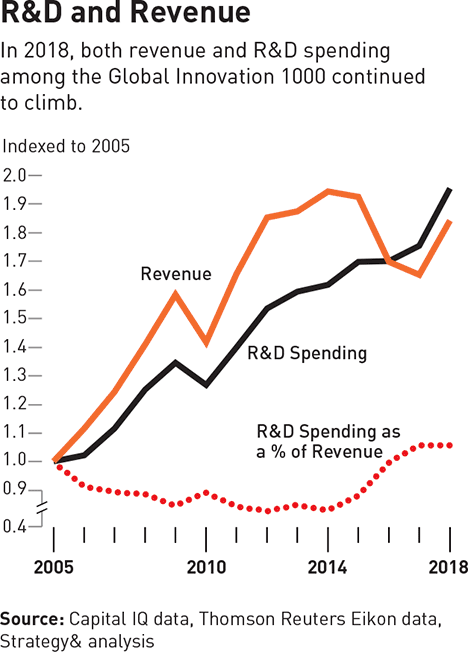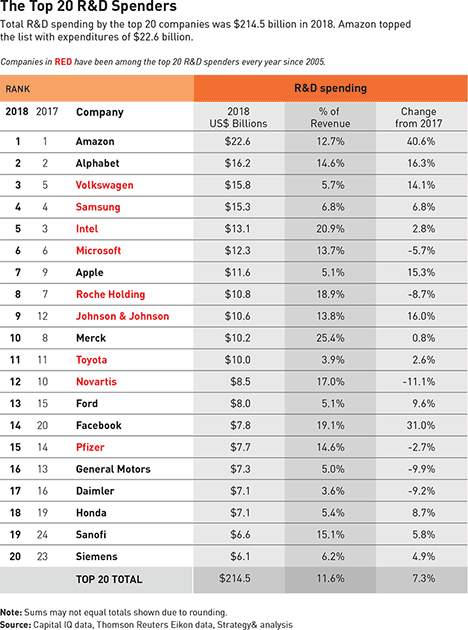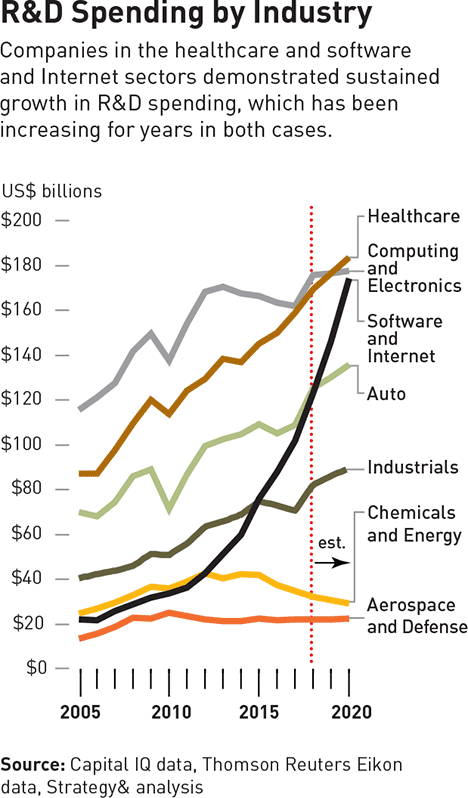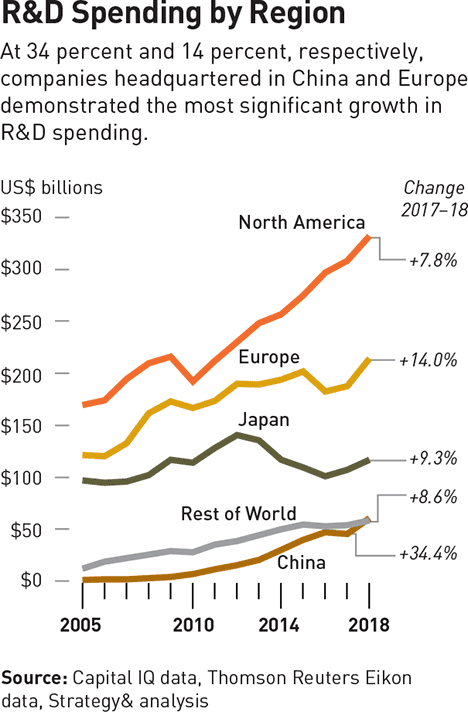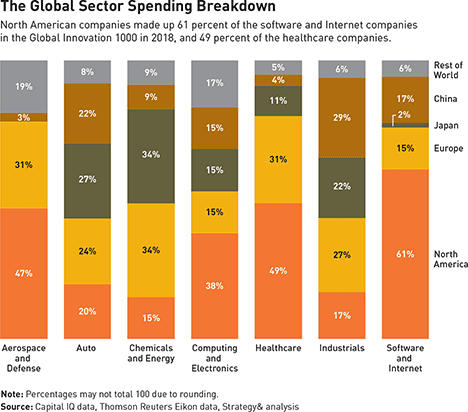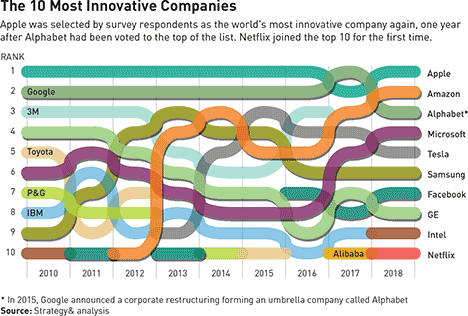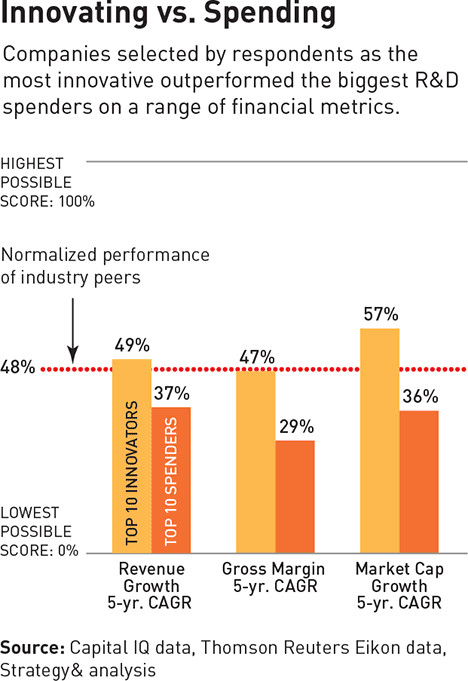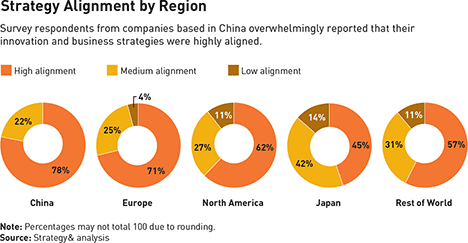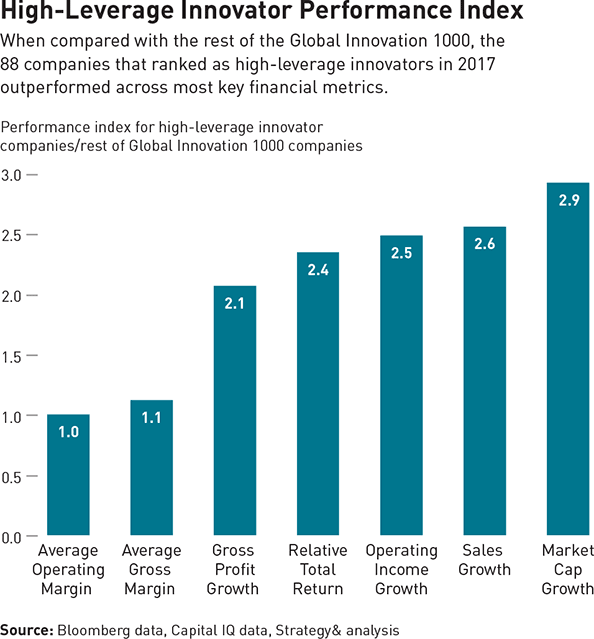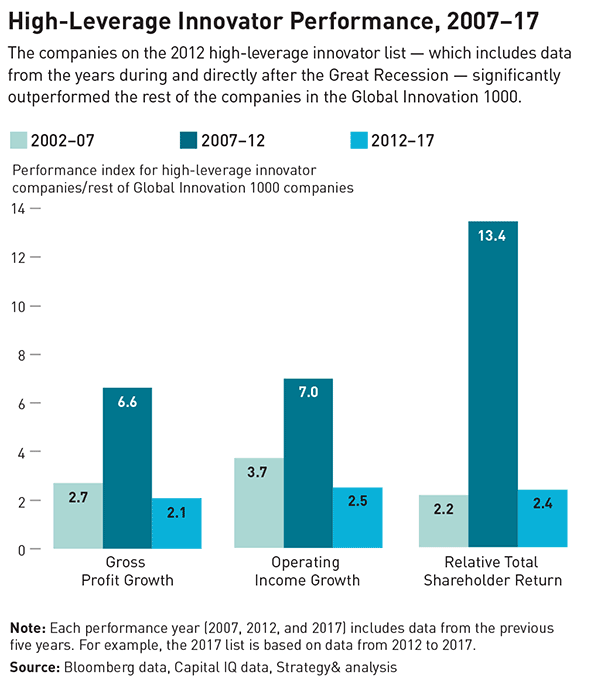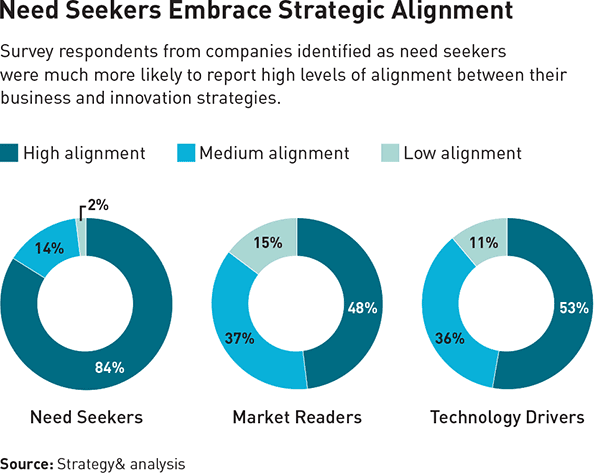What the top innovators get right
With careful attention to six key areas, companies can make the most of their R&D investment and outpace the competition.

A project team from Stanley Black & Decker, a US$12.7 billion diversified manufacturing firm, noticed something problematic when observing customers using the company’s products at construction sites. Tools such as miter saws and table saws needed higher voltage than the 20-volt systems commonly used for hand tools such as drills and circular saws. As a result, contractors were using extension cords or gasoline generators. But the former were inconvenient and created hazards, and the latter brought noise and pollution. After making these observations, Stanley Black & Decker developed the DeWalt line of “FlexVolt” cordless power tools and battery packs. They’ve been quickly embraced by professional contractors — generating $300 million in incremental sales since the line’s 2016 introduction.
“Cords are one of the biggest pain points on a construction jobsite,” says Stephen M. Subasic, vice president of human resources at the company’s global tools and storage unit. “Our customers were telling our teams they wanted more cordless options.” But end-users had an additional constraint: They had made large investments in existing 20-volt tools and were unwilling to give them up. The FlexVolt system solved the problem. “We were able to marry some emerging technologies in motors and batteries so that the FlexVolt system automatically adjusts to the voltage of the tool,” says Subasic. “It’s a single-battery platform that addresses the pain point, and spans both the next generation and the current generation of tools.”
Few companies are able to bring this kind of rapid breakthrough innovation from concept to market success. But Stanley Black & Decker has consistently developed winning products for years, and has been doing so while spending its R&D dollars more efficiently than its industry peers. In this year’s Global Innovation 1000 study — our annual analysis of the 1,000 publicly held companies that spend the most on research and development (R&D) — we look at a subset of companies like Stanley that we call “high-leverage innovators.” These are companies that outperformed their industry groups on seven key measures of financial success for the previous five years, while at the same time spending less on R&D as a percentage of sales.
Achieving high performance is difficult in any given year, and remarkably difficult to sustain. But the success of these high-leverage innovators reaffirms a finding of our study that has held true over time: There is no long-term correlation between the amount of money a company spends on its innovation efforts and its overall financial performance. Instead, what matters is how companies use that money and other resources to create products and services that connect with their customers. Also important is the quality of companies’ talent, processes, and decision making.
R&D spending among the Global Innovation 1000 overall increased 11.4 percent in 2018, to a record high of $782 billion, reflecting R&D spending increases in all regions and nearly all industries (see “Profiling the Global Innovation 1000”). If we carve out the high-leverage innovators, we see that the 88 companies that earned that classification in 2017 had sales growth 2.6 times as high as other companies on the Global Innovation 1000 list from 2012 to 2017 and growth in market capitalization 2.9 times as high, while their R&D intensity (R&D expenditures as a percentage of sales) was lower than their industry median. These high-leverage innovators can be found in all regions and industries. They include household brands such as Apple, Adidas, and Stanley Black & Decker, and companies that may be less familiar to readers, such as Amadeus IT Group, a global provider of travel solutions and software based in Spain, and DIC Corporation, a Japan-based specialty chemicals company.
Profiling the Global Innovation 1000
The companies in the Global Innovation 1000 spent US$782 billion on R&D in 2018. This represented record-high spending, and an increase of 11.4 percent over 2017. Year-on-year growth in 2018 was nearly four times as high as growth between 2016 and 2017, when spending increased by 3.2 percent. Revenues for the Global Innovation 1000 also increased by 11.4 percent, leaving R&D intensity, or innovation spending as a percentage of revenue, unchanged from 2017 (at 4.5 percent) and maintaining the 14-year high (see “R&D and Revenue”).
Total R&D spending by the top 20 companies was $214.5 billion, or 27.4 percent of the total spending by the Global Innovation 1000. For the second year in a row, Amazon led the top 20 list, with spending of $22.6 billion — up a massive 40.6 percent from 2017. It was followed, as was also the case last year, by Alphabet, with R&D expenditures of $16.2 billion (see “The Top 20 R&D Spenders”). Facebook posted the biggest climb on the top 20 list, up six places from its 2017 position to number 14. Sanofi and Siemens rejoined the list this year, after falling outside the top 20 in 2016 and 2012, respectively. Four industries — software and Internet, auto, healthcare, and computing and electronics — accounted for more than 97 percent of the top 20’s R&D spending.
Taking a broad look at industry spending, with the exception of aerospace and defense and chemicals and energy, all industries increased their R&D spending in 2018. R&D spending rose in the four industries that accounted for 76 percent of total R&D spending — computing and electronics, healthcare, auto, and software and Internet, the same four that dominate the top 20. But the spending growth trajectories for these industries have shifted.
Spending had been flat for more than five years in the computing and electronics industry up to 2017, and we predicted in last year’s study that healthcare would likely take the number one spot in 2018. Instead, a $13 billion R&D spending surge in computing and electronics — almost a third of which was attributable to increased spending at Samsung and Apple — kept computing and electronics companies on top, despite continued growth in healthcare.
Software and Internet companies, whose research and development spending has been rising sharply for several years, similarly seemed poised to surpass auto companies’ spending in 2018. Instead, R&D spending in the auto sector, likely focused on electronics, software, and autonomous vehicles, jumped $16 billion. That was a 15.2 percent year-over-year increase, and it kept auto in third place. The growth trajectory of software and Internet companies, however, continues to suggest they will rise higher on the list (see “R&D Spending by Industry”).
Companies headquartered in all regions increased their R&D spending in 2018 (see “R&D Spending by Region”), but the most vibrant innovation investment was in China and Europe. Chinese companies led in R&D spending increases by a wide margin, up 34.4 percent. They also registered the biggest increase (16 percent) in the number of companies on the Global Innovation 1000 list (see “China’s R&D Success Story”). European companies were second in both R&D spending growth (14 percent) and gains in the number of entries in the Global Innovation 1000 (7 percent).
North American, Japanese, and “rest of world” companies all had R&D spending growth in the single digits, and all three regions saw declines in the number of companies on the list. North America did retain the lead in the number of innovators in several sectors, including software and Internet companies (61 percent), healthcare (49 percent), aerospace and defense (47 percent), and computing and electronics (38 percent) (see “The Global Sector Spending Breakdown”).
R&D spending among the Global Innovation 1000 overall increased 11.4 percent in 2018, to a record high of $782 billion.
We tailored our analysis this year to determine what sets high-leverage innovators apart from their competitors, interviewing innovation leaders and studying the innovation programs at a number of companies on the list. We also surveyed a sample of leaders and managers — 869 in all — to gain insights about where they are focusing their innovation efforts, how their innovation approaches are changing, what different innovation models they are pursuing, and how well they are succeeding. We separated out those companies that reported they were outperforming their competitors in terms of growth and profitability, and noted how their innovation practices contrasted with those that reported growth similar to or slower than that of their peers.
Our analysis reveals that both the high-leverage innovators and the larger universe of companies that report relative high performance have six key characteristics. The first five are widely understood, though executed to varying degrees. The sixth is something that only the best innovators accomplish.
1. They closely align innovation strategy with business strategy.
2. They create company-wide cultural support for innovation.
3. Their top leadership is highly involved with the innovation program.
4. They base innovation on direct insights from end-users.
5. They rigorously control project selection early in the innovation process.
6. They excel at each of these first five characteristics and have been able to integrate them to create unique customer experiences that can transform their market.
For companies looking to improve the reach and results of their R&D investment, examining the strategies of those that consistently perform at the top of their game offers invaluable insight.
Inside the High-Leverage Innovators
We first conducted the high-leverage innovator analysis in 2006, finding 94 companies that fit the criteria, and then created the list again in 2007, identifying 118. For this year’s study (when we found 88 such companies), we compared the list across three years — 2007, 2012, and 2017 — to provide a 15-year performance window (each list draws on the previous five years of data). Only two companies qualified as high-leverage innovators in all three years: Stanley Black & Decker and Apple — Silicon Valley’s poster child for innovation excellence and the perennial leader of our “10 Most Innovative Companies” list.
The 10 Most Innovative Companies
After ceding its lead position to Alphabet in 2017, Apple was once again selected by our Global Innovation 1000 survey respondents as the most innovative company in 2018 (see “The 10 Most Innovative Companies”). Apple also became the first publicly listed U.S. company in history to achieve a US$1 trillion market capitalization in 2018. We would argue that it’s not a coincidence: What’s driven Apple’s commercial and financial success, after all, is its ability to design and develop distinctive new products and services and bring them to market successfully.
Overall, the list of the 10 most innovative companies has a distinctly digital feel. Three companies are in the computer and electronics sector (Apple, Samsung, and Intel), and five are in the software and Internet sector (Amazon, Alphabet, Facebook, Microsoft, and Netflix). The single auto company on the list is Tesla, whose Model 3 electric car was described in a Washington Post review as an “iPhone with wheels.” The only traditional industrial company on the list, General Electric, has taken pains in recent years to describe itself as a “digital industrial company.”
Amazon — which in September 2018 became the second U.S. company to cross the trillion-dollar value mark — was first voted onto the list by respondents to our 2012 survey, appearing in 10th place. It has climbed ever higher by dominating the booming e-commerce sector and developing its successful cloud computing business, Amazon Web Services. The company, which was ranked the second-most innovative company in 2018, also led the list of the biggest R&D spenders this year, with innovation outlays of $22.6 billion — a year-over-year increase of 40.6 percent. Alphabet, number three on this year’s 10 Most Innovative Companies list, was second in spending, with outlays of $16.2 billion.
But innovation, as we’ve long argued, is not primarily a reflection of how much you spend. Apple spent less in 2018 on R&D as a percentage of sales than eight of the other nine companies selected by respondents as the most innovative — a mere 5.1 percent of sales, compared with 20.9 percent for Intel, 19.1 percent for Facebook, 14.6 percent for Alphabet, and 12.7 percent for Amazon. (General Electric had the lowest R&D intensity, at 4.0 percent.) Apple was also the only company from the 2017 high-leverage innovator list to be selected by survey respondents as being among the most innovative. Adidas, another 2017 high-leverage innovator, fell just outside the top 10 (number 11).
Comparing financial metrics, the 10 most innovative companies outperformed the 10 biggest R&D spenders on revenue growth, gross margin, and market cap growth (see “Innovating vs. Spending”).
One of the notable changes to the high-leverage innovator list since its earlier iterations has been the dramatic rise of companies headquartered in China, from 3 percent of the total in 2007 to 17 percent in 2017 — a net increase of more than 400 percent (see “China’s R&D Success Story”). The number of high-leverage innovators in Europe also increased significantly, from representing 18 percent of the total number in 2007 to representing 30 percent in 2017. Meanwhile, the number of high-leverage innovators fell 45 percent for North American companies, 8 percent for Japanese companies, and 23 percent for the “rest of world” countries.
China’s R&D Success Story
by Patrick Hui and Barry Jaruzelski
When we first published the Global Innovation 1000 study in 2005, only eight companies on the list were headquartered in China, accounting for a negligible amount of R&D spending. In 2018, 145 Chinese companies were among the top 1,000 spenders, and their innovation spending increased 34.4 percent over 2017 — or nearly three times the overall rate of increase among the Global Innovation 1000 between 2017 and 2018. R&D spending by Chinese companies is concentrated (representing 86 percent of total spending) in industrials — where China has a larger share of Global Innovation 1000 companies than any other region — software and Internet, auto, and computing and electronics.
Chinese companies also carved out a sizable stake of the high-leverage innovator list, making up 17 percent of this group in 2017, compared with 3 percent in 2007 — a net increase of more than 400 percent. Notably, Europe was the only other region for which the number of high-leverage innovators increased; North America, Japan, and the “rest of world” category all saw declines (see “2017 High-Leverage Innovators”).
China’s R&D activities have placed it toward the top of other lists as well. In 2018, China broke into the list of the world’s 20 most innovative economies, according to the Global Innovation Index (GII), an annual ranking of innovation competitiveness (note: PwC’s Strategy& was a Knowledge Partner of the GII in 2017 and 2018). Coming in at number 17 (of the 126 economies ranked), China was the only middle-income country to make the top 20. The GII report noted, “In absolute values, and in areas such as R&D expenditures and the number of researchers, patents, and publications, China is now 1st or 2nd in the world…. China presents an impressive example for other middle-income countries to follow as they seek to join the echelons of high-income economies. With this success in mind, China’s attention is now turning to the quality and impact of innovation.”
One reason for China’s rise as an R&D leader is simply the vibrancy of the country’s economy in the 21st century. China’s GDP has expanded at rates not seen in most other regions for many decades. The Chinese government has also consistently made R&D a top agenda item for the five-year plans that set the economy’s direction. Business sectors singled out for innovation investment and incentives in China’s current five-year plan include new-energy automotive, high-end robotics, next-generation information technology, and advanced medical equipment. Recently, trade tensions with the U.S. have led the Chinese government to spur innovation in semiconductors — making multibillion-dollar investments in startups to ensure that China’s technology companies are not dependent on U.S. suppliers.
Another critical factor underlying China’s R&D rise reflects Chinese companies’ focus on some of the innovation success factors that this year’s study identifies. In our 2018 survey, Chinese companies reported an alignment of innovation and business strategy that was better than those in other regions: For example, 78 percent of Chinese companies said their strategies were highly or closely aligned, as compared with 62 percent for North American companies (see “Strategy Alignment by Region”). Companies headquartered in China lead other regions by similar margins on indicators such as their executive team’s involvement in innovation strategy and company-wide cultural support for innovation programs.
We also found that the need seeker strategy is a more prevalent innovation model in China than in other regions (44 percent among companies headquartered in China, versus 34 percent for all companies in our survey). The need seeker model — which previous research found was also most prevalent among Silicon Valley innovators (pdf) — is the most common model followed by companies that report higher revenue growth and profitability than their industry peers.
- Patrick Hui is a partner with PwC China, based in Shenzhen and Hong Kong. He works with multinational corporations and public organizations to conduct large-scale operations transformations, improve their supply chain operations, and enhance their product innovation capabilities.
Among industries, the number of high-leverage innovators rose between 2007 and 2017 in telecommunications, consumer goods, healthcare, industrials, autos, and aerospace and defense, while the numbers fell in chemicals and energy, computing and electronics, and software and Internet. Looking at all three years, in 2007 the industry with the largest presence on the list was computing and electronics, in 2012 it was computing and electronics and healthcare (tied), and in 2017 it was healthcare.
High-leverage innovators had operating and gross margins similar to those of other Global Innovation 1000 companies for the five years ending in 2017, but significantly outperformed them on five other financial metrics, including gross profit growth (which for high-leverage innovators was 2.1 times as high as that of other companies) and market capitalization growth (2.9 times as high) (see “High-Leverage Innovator Performance Index”).
During the three five-year periods ending in 2007, 2012, and 2017, high-leverage innovators’ relative outperformance decreased on two key measures — gross profit growth and operating income growth — although relative total shareholder returns increased slightly. This likely reflects a general improvement in the overall performance of the Global Innovation 1000 companies over time. But the data also reveals a startling fact: The high-leverage innovators vastly outperformed other companies in the 2007–12 period, which spans the last major business downturn and the first years of the current expansion. This suggests that during the Great Recession, high-leverage innovators recovered more quickly and robustly. In fact, they blew the doors off the competition in gross profit growth (which was 6.6 times as high as that of other companies), operating income growth (7.0 times as high), and total shareholder returns, which were 13.4 times those of the rest of the companies in the Global Innovation 1000 (see “High-Leverage Innovator Performance, 2007–17”).
Characteristics of Successful Innovators
In analyzing our survey respondents’ answers to questions about innovation practices and strategies, we found sharp differences between companies reporting fast revenue growth (43 percent of respondents) and those reporting similar or less success than their peers (48 percent said they were growing at the same rate as their peers and 9 percent said they were growing more slowly). Moreover, survey respondents who reported that their companies were outperforming their competitors have many of the same approaches and attitudes toward innovation that the high-leverage innovators exemplify.
Strategic alignment. Respondents who reported that their companies were outperforming their industry groups were far more likely to report strategic alignment. Of that group, 77 percent said their innovation strategies were highly or closely aligned with their business strategies, compared with 54 percent of respondents who reported growth typical of their peers, and 32 percent of respondents who reported slower growth. Similar differences hold true for companies that reported higher profitability.
We also found differences when it came to strategic alignment among the three innovation models into which we have segmented companies over the past 11 years: Need Seekers, Market Readers, and Technology Drivers. In our survey this year, need seekers made up 34 percent of total respondents. (Note: Figures have been rounded.) These companies engage customers directly to generate new ideas, then develop original products and services and get them to market first. Market readers, accounting for 23 percent of our respondents, are fast followers. They typically generate ideas by closely monitoring their markets, customers, and competitors, focusing largely on creating value through incremental innovations to current products. Technology drivers, 44 percent of our respondents, depend heavily on their internal technological expertise to develop new products and services, driving both breakthrough innovation and incremental change, in hopes of meeting the known and unknown needs of their customers via new technology.
It is helpful to consider the breakdown of responses by innovation model, given need seekers’ own perception of relative success: 65 percent of need seekers report they have higher profitability than their peers, as compared with 38 percent of market readers and 43 percent of technology drivers. And need seekers also report higher revenue growth (59 percent) than market readers (35 percent) and technology drivers (36 percent). It is significant, then, that 84 percent of need seekers say their innovation and business strategies are closely aligned, whereas this is true for only 48 percent of market readers and 53 percent of technology drivers (see “Need Seekers Embrace Strategic Alignment”).
Conversations with innovation leaders at high-leverage innovator companies revealed a similar focus on alignment. At Amadeus IT, “our ambition is to have a strong alignment between our business strategy and the innovation strategy,” says Marion Mesnage, head of research, innovation, and ventures. “We’ve increased the alignment and are strengthening it.” In the past, R&D at the company — a $5.8 billion global travel software and information technology business headquartered in Spain — tended to be technology-centric, Mesnage says. But it is shifting its focus more toward understanding customer needs and identifying growth opportunities within the company’s business units, which serve airlines, hotels, tour operators, insurers, car rental and railway companies, ferry and cruise lines, travel agencies, and individual travelers. “Right now,” says Mesnage, “we are running strategy sprints to gather people in the same room from different business units with the end goal of co-creating our next wave of innovation themes.”
At DIC, a Japan-based global manufacturer of printing inks, organic pigments, and synthetic resins, top management has also moved in recent years to align the company’s R&D activities more closely with its business strategies. DIC splits R&D operations into two divisions. The direct-to-customer technology division, which focuses on incremental innovation, is always in sync with the business strategy and works closely with the business units. “The organization of these activities is quite closely linked,” says Kiyotaka Kawashima, executive officer and general manager of R&D. “The budget control and administration are both done by the business units, and they approve the themes of technology and R&D.” A separate division, which focuses on basic innovation, has also been more closely aligned with the business strategy in recent years, but has more leeway in deciding which projects to pursue.
Cultural support. Seventy-one percent of respondents who reported that their company’s revenues were growing faster than competitors’ revenues said their corporate culture was highly or very aligned with their innovation strategy, compared with 53 percent of companies that reported the same growth as competitors, and 33 percent for companies that reported slower growth. The differentials on cultural alignment were similar for companies that reported higher profitability.
We also found differences in cultural support by innovation model. Need seekers are far better at turning their corporate culture to their advantage: 82 percent said their organization’s culture was highly supportive of the innovation strategy, compared with 48 percent for market readers and 47 percent for tech drivers.
CEO Tim Cook of Apple (which we have long identified as a need seeker) has said that innovation is in the company’s DNA, and that its culture is not something that can be formulaically copied. But he has given some clues about how Apple fosters that culture — for example, by hiring smart people who can collaborate cross-functionally. “You look for people that are not political,” Cook said in a 2013 interview with the dean of Duke’s Fuqua School of Business (Cook’s an alumnus). “You look for wicked smart people...who appreciate different points of view…. The reason Apple is special is we focus on hardware, software, and services. And the magic happens where those three come together…. It’s unlikely that somebody that’s focused on one of those in and of itself can come up with magic, and so you want people collaborating in such a way [that] you can produce these things that can’t be produced otherwise.”
Amadeus IT is focused on building cultural support across its 45 locations worldwide (the company’s main R&D hubs are in France, Germany, India, the U.K., and the U.S.). “We are made up of people who have a great appetite for new things, for exciting technology, and for new opportunities,” says Mesnage. Innovation teams are very multicultural, she adds, “which creates a great ground for creativity and for exchanging different perspectives.” One of the practices Amadeus has adopted is creating a system of innovation champions within its R&D and business units, whose role is to promote and foster the company’s innovation approach at their site, and to encourage people to submit ideas — and then collect those ideas to make sure they’re visible to the rest of the organization.
Executive involvement. Survey respondents reporting higher revenue growth than competitors were much more likely to say their company’s executive team was closely involved with the R&D program — 78 percent said their executive team was highly or closely aligned with R&D investment and strategy, compared with 62 percent for same-growth companies, and 53 percent for slower-growth companies.
Among innovation models, most need seekers reported that their leadership teams were plugged into their innovation programs: 84 percent of need seekers reported that their executive team was highly involved in decision making regarding R&D investment and strategy, compared with 63 percent of market readers and 57 percent of tech drivers.
All the high-leverage innovators we interviewed or analyzed said their executive teams were highly aligned with their innovation programs. Stanley Black & Decker is a case in point.
“The executive team is involved in innovation right from the top,” says Tim Hatch, chief technology officer at Stanley Engineered Fastening. “Our CEO mentions breakthrough innovation whenever I hear him speak in a group. Whenever we have project reviews or product reviews, he is always asking questions around where we are with breakthroughs and how we are commercializing the ideas that have been generated by the teams. And as you go down from his level to the business unit level, there are similar levels of engagement.”
At Apple, innovation has always been a top executive-team agenda item. It helps to start with a visionary founder (the late Steve Jobs), but Apple has also elevated innovation — and specifically, design — within the organization. Jony Ive, for example, who has run Apple’s design studio since 1996, was named chief design officer in 2015. He reports directly to the CEO, and his responsibilities include the look and feel of Apple hardware, user interface, packaging, and major architectural projects such as Apple Park and Apple’s retail stores, as well as new ideas and future initiatives.
Focus on customer insights. All of our survey respondents — those who reported their growth as faster, slower, or the same as that of their peers — value deep customer and consumer insights in their innovation programs. They ranked consumer and client insights as the most important capability during the ideation stage. However, interestingly, respondents who reported revenue growth that was the same as or slower than that of their peers believe they are most competent in this capability, whereas those who reported faster revenue growth ranked it as a capability in which they have the second-most competence. This may seem counter-intuitive, but actually makes a good deal of sense. Those who reported slow or similar growth compared with their peers’ growth seem to think that they have done enough in this area. Those who reported fast growth see further opportunities for improvement.
Looking at the innovation models, need seekers — which rely heavily on customer insights — also chose customer insights as their second-best competency. But market readers and tech drivers chose it as their top competency. Overall, the top innovators seem to recognize that when it comes to gathering customer insights, no company is ever done learning.
DIC has focused on gaining direct customer insights into some of its most successful innovations. One of the company’s main businesses is producing components and materials for the color filters of liquid crystal displays used in TVs, computers, and other devices — especially the red, blue, and green pigments they utilize. Technology in this field has advanced rapidly over the last 10 years, according to R&D general manager Kawashima, and typically a long supply chain distances the end-users from the process and materials providers such as DIC. The innovation team sought end-user feedback at a very early stage of development for its latest color filter innovations, and was able to incorporate the insights and utilize its production know-how to create pigments superior to its competitors’ offerings. Today, DIC’s market share for green pigment is 80 percent, and it is 50 percent for blue.
Direct end-user input played a major role in the turnaround of Adidas that began in the 1990s (see “How Adidas Found Its Second Wind,” s+b, Aug. 24, 2015). A new management team set out to recapture the innovation mojo that had characterized the athletic footwear company during the leadership of the founder, Adi Dassler, who died in 1978. Dassler had started the company with a simple approach: He observed athletes, talked to them about their needs, and then experimented with novel ways of solving their problems. The new team renewed Dassler’s approach, focused on performance-related design and industrial craftsmanship, and rebuilt Adidas’s product line.
Adidas is now focusing on open source innovation and co-creation with customers to develop new ideas. Says CEO Kasper Rørsted: “We look at all kinds of collaborative creation as valuable — not only within our company, but with external partners as well. We are clear about the borders of our brand, because the brand is sacred to us. But we also recognize that if we have only the inspiration and creativity of people within our own organization, we miss a lot of what’s going on in the marketplace. We articulate this point by saying that we need to be consumer-obsessed and to create the best product for the consumer. If that is your endgame, then you have to be able to confront sacred cows, and open yourself up to ideas that you might not have been open to in the past.” Adidas’s innovation approach has been key to its return to the ranks of top innovators and financial performers — and its ranking as one of our high-leverage innovators for the 2012–17 period.
Focus on project selection. When asked which stage of the innovation process — ideation, project selection, product development, or commercialization — was most important, 35 percent of our survey respondents chose project selection, followed by 31 percent for ideation. This “front end” of the innovation process is indeed critical to success. For one thing, most of the long-term costs of product development — as much as 70 percent, in our experience — are locked in at the ideation and project selection phases. And even great operational capabilities and business management cannot overcome poor decisions about which ideas to move into development and production.
Companies reporting relatively faster growth said they were most competent at the ideation and project selection stages, but they were more likely than those reporting slower growth to see even more potential improvement in their project selection capabilities: 42 percent of the fast-growth companies saw project selection as the stage with the most opportunity for improvement in their company, compared with 30 percent of same-growth companies and 31 percent of slower-growth companies.
Need seekers are also more eager to improve the project selection phase of the innovation process — 42 percent said this is the innovation stage where most improvement is needed, compared with 29 percent of market readers and 33 percent of tech drivers — while they put less emphasis on improving product development.
Stanley Black & Decker is among the group of companies hungry for more. “I would agree that project selection is the area where we have the biggest opportunity for improvement,” says Hatch, the CTO of Stanley Engineered Fastening. The core product development teams are challenged to find the next iteration or big step from a current product, and then are measured very tightly on delivering on the product time line, he says, “100 percent, on time, on cost, on delivery.” The breakthrough innovation teams, however, are challenged to go after projects that might not be a success. “If everything we do is a success,” Hatch says, “then we’re not trying hard enough and not going far enough from the core.”
Amadeus IT has a similar focus. Innovation leaders track the portfolio precisely and have explicit criteria for project selection. “It’s not like we create something and then commercialize it,” says Mesnage, head of research. “It’s all about making sure that we have a problem–solution fit — that we’ve really found a problem worth solving, that we have a solution in mind that can solve it, and that there is a business appetite, so that we know there are enough people willing to pay for the solution we are proposing.” One recent product innovation that grew out of the company’s revamped innovation approach is Amadeus Video Solutions, an interactive video player that enables travel providers to show consumers videos about travel destinations and pause the video at any time to see the location on a map; check and price travel, lodging, and activity options nearby; and make purchases without leaving the platform.
The New Innovation Excellence
Not long ago, companies that aimed for innovation excellence might have felt it was sufficient to be good at most of the five characteristics discussed above, and best-in-class at one or two. But the standard for innovation excellence has been rising as businesses have become more competitive in the 21st century — which the Global Innovation 1000 studies have shown for many years. Companies that aspire to the highest level of innovation leadership today need to excel at every aspect of innovation. And they need to make them converge in a way that pushes the boundaries of market expectations and transforms the customer experience. Here we can revisit the two companies that made the high-leverage innovator list throughout the entire 15-year performance window of our analysis.
Apple’s innovation mind-set is thoroughly integrated in the mission as well as the organization of the company. When asked in a Fast Company interview what outsiders might misunderstand or underappreciate about Apple, CEO Cook said: “The thing they might miss is how different Apple is versus other technology companies. A financial person just looking at revenues and profits may think, ‘They’re good [at making money].’ But that’s not who we are. We’re a group of people who are trying to change the world for the better…. For us, technology is a background thing. We don’t want people to have to focus on bits and bytes and feeds and speeds. We don’t want people to have to go to multiple [systems] or live with a device that’s not integrated. We do the hardware and the software, and some of the key services as well, to provide a whole system.”
As noted earlier, Apple emphasizes the importance of cross-functional collaboration. When the company built its new $5 billion headquarters (completed in 2018), which has been likened to a spaceship, the architecture and building design revolved around encouraging creativity and innovation, in much the same way that some of the icons of innovation architecture — the mid-20th-century Bell Labs model of collaborative workspace and MIT Media Lab’s technology research hub — were designed to encourage interdisciplinary interaction.
Stanley Black & Decker has long been known as a product innovation leader in its field, but CEO James M. Loree has set ambitious goals. He told The Street in August 2018, “We want to be known as one of the world’s most innovative companies. So we have created an enormous wave of innovation at this point…embedded in the culture of Stanley Black & Decker. We have stepped up and we are doing breakthrough innovation activities. We are doing venture investing. We are doing accelerators for entrepreneurs externally and internally.” In the company’s 2017 year in review for shareholders, Loree wrote that the company currently had “10 breakthrough innovation teams covering all businesses and multiple worldwide locations focused on developing innovations that each have the potential to deliver greater than $100 million in annual revenues.”
Stanley is advancing its innovation ecosystem along many dimensions, including Stanley Ventures in Silicon Valley, which invests in innovative startups; an additive manufacturing accelerator program in Hartford, Conn., in partnership with Techstars; a digital accelerator in Atlanta; and an industrial incubator in Silicon Valley. “The innovation strategy is globally distributed and diverse, yet holistic and seamlessly integrated into our businesses,” says Mark Maybury, Stanley Black & Decker’s chief technology officer. “The reality we’re facing is that if we want to maintain or continue to grow our leadership position, we need to focus not only on the incremental innovations that pay the bills today, but also on the things that will shape the industries in which we compete.”
The consistent success of Apple, Stanley, and the other star performers on our high-leverage innovators list sets a performance goal that all innovators can aspire to reach. But the fact that relatively few of the Global Innovation 1000 companies are able to hit that target in a given year — let alone repeatedly over time — is a reminder that innovation excellence isn’t something that can be bought by simply spending more on R&D. Rather, it’s the result of painstaking attention to strategy, culture, executive involvement, customer insights, and execution throughout the stages of innovation, all with an eye toward creating differentiated experiences.
Methodology
As it has in each of the past 13 editions of the Global Innovation 1000, this year Strategy&, PwC’s strategy consulting business, identified the 1,000 public companies around the world that spent the most on R&D during the last fiscal year, as of June 30, 2018. To be included, companies had to make their R&D spending numbers public. Subsidiaries that were more than 50 percent owned by a single corporate parent during the period were excluded if their financial results were included in the parent company’s financials. The Global Innovation 1000 companies collectively account for 40 percent of the world’s R&D spending, from all sources, including corporate and government sources.
In 2013, Strategy& made some adjustments to the data collection process in order to gain a more accurate and complete picture of innovation spending. In prior years, both capitalized and amortized R&D expenditures were excluded. Starting in 2013, we included the most recent fiscal year’s amortization of capitalized R&D expenditures for relevant companies in calculating the total R&D investment, while continuing to exclude any non-amortized capitalized costs. We have now applied this methodology to all previous years’ data; as a result, historical data referenced in the studies from 2014 onward will not always align with previously published figures for the 2005 through 2012 studies.
For each of the top 1,000 companies, we obtained from Capital IQ and Thomson Eikon the key financial metrics for 2013 through 2018, including sales, gross profit, operating profit, net profit, historical R&D expenditures, and market capitalization. All sales and R&D expenditure figures in foreign currencies were converted into U.S. dollars according to an average of the exchange rate over the relevant period; for data on share prices, we used the exchange rate on the last day of the period.
All companies were coded into one of nine industry sectors (or “other”) according to Capital IQ’s industry designations, and into one of five regional designations, as determined by their reported headquarters locations. To enable meaningful comparisons across industries, the R&D spending levels and financial performance metrics of each company were indexed against the average values in its own industry.
Finally, to understand the ways in which global R&D is and will be conducted at companies across multiple industries, Strategy& conducted an online survey of 869 innovation leaders and managers around the world. The companies participating represented more than US$130 billion in R&D spending, or 17.1 percent of this year’s total Global Innovation 1000 R&D spending; all nine of the industry sectors; and all five geographic regions.
Author profiles:
- Barry Jaruzelski is a thought leader on innovation for Strategy&, PwC’s strategy consulting business. Based in Florham Park, N.J., he is a principal with PwC US. He works with high-tech and industrial clients on corporate and product strategy and the transformation of core innovation processes. He created the Global Innovation 1000 study in 2005, and in 2013 was named one of the “Top 25 Consultants” by Consulting magazine.
- Robert Chwalik is an advisor to executives in the automotive, industrials, and oil and gas sectors for Strategy&, helping them improve both top-line growth and bottom-line performance in such key operational and strategic areas as global engineering and product innovation. He is a principal with PwC US and is based in New York.
- Brad Goehle is an advisor to executives on innovation and product development for Strategy&, helping companies in the aerospace and defense, automotive, and industrial sectors with product and portfolio strategy, engineering, and enterprise transformation. He is a managing director with PwC US and is based in Arlington, Va.


